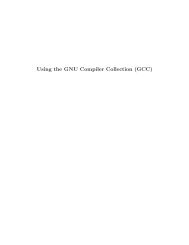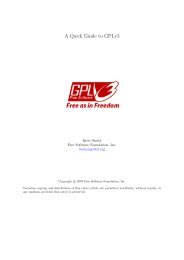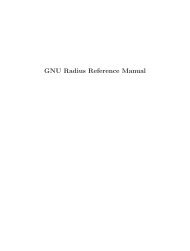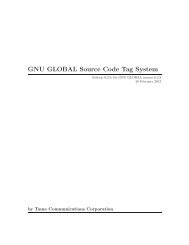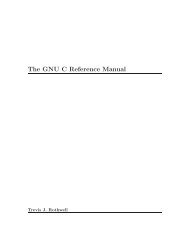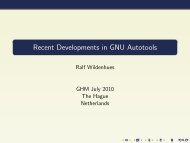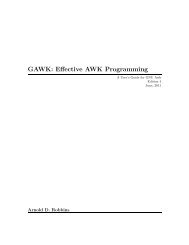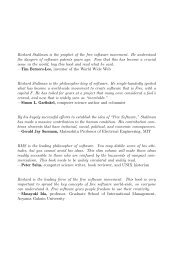by Trent A. Fisher and Werner Lemberg - The GNU Operating System
by Trent A. Fisher and Werner Lemberg - The GNU Operating System
by Trent A. Fisher and Werner Lemberg - The GNU Operating System
You also want an ePaper? Increase the reach of your titles
YUMPU automatically turns print PDFs into web optimized ePapers that Google loves.
Chapter 2: Invoking groff 15<br />
2.6 Invocation Examples<br />
This section lists several common uses of groff <strong>and</strong> the corresponding comm<strong>and</strong><br />
lines.<br />
groff file<br />
This comm<strong>and</strong> processes ‘file’ without a macro package or a preprocessor.<br />
<strong>The</strong> output device is the default, ‘ps’, <strong>and</strong> the output is sent to stdout.<br />
groff -t -m<strong>and</strong>oc -Tascii file | less<br />
This is basically what a call to the man program does. gtroff processes the<br />
manual page ‘file’ with the ‘m<strong>and</strong>oc’ macro file (which in turn either calls<br />
the ‘man’ or the ‘mdoc’ macro package), using the tbl preprocessor <strong>and</strong> the<br />
ASCII output device. Finally, the less pager displays the result.<br />
groff -X -m me file<br />
Preview ‘file’ with gxditview, using the ‘me’ macro package. Since no ‘-T’<br />
option is specified, use the default device (‘ps’). Note that you can either say<br />
‘-m me’ or ‘-me’; the latter is an anachronism from the early days of UNIX. 1<br />
groff -man -rD1 -z file<br />
Check ‘file’ with the ‘man’ macro package, forcing double-sided printing –<br />
don’t produce any output.<br />
2.6.1 grog<br />
grog reads files, guesses which of the groff preprocessors <strong>and</strong>/or macro<br />
packages are required for formatting them, <strong>and</strong> prints the groff comm<strong>and</strong><br />
including those options on the st<strong>and</strong>ard output. It generates one or more<br />
of the options ‘-e’, ‘-man’, ‘-me’, ‘-mm’, ‘-mom’, ‘-ms’, ‘-mdoc’, ‘-mdoc-old’,<br />
‘-p’, ‘-R’, ‘-g’, ‘-G’, ‘-s’, <strong>and</strong> ‘-t’.<br />
A special file name ‘-’ refers to the st<strong>and</strong>ard input. Specifying no files<br />
also means to read the st<strong>and</strong>ard input. Any specified options are included<br />
in the printed comm<strong>and</strong>. No space is allowed between options <strong>and</strong> their<br />
arguments. <strong>The</strong> only options recognized are ‘-C’ (which is also passed on)<br />
to enable compatibility mode, <strong>and</strong> ‘-v’ to print the version number <strong>and</strong> exit.<br />
For example,<br />
grog -Tdvi paper.ms<br />
guesses the appropriate comm<strong>and</strong> to print ‘paper.ms’ <strong>and</strong> then prints it to<br />
the comm<strong>and</strong> line after adding the ‘-Tdvi’ option. For direct execution,<br />
enclose the call to grog in backquotes at the UNIX shell prompt:<br />
‘grog -Tdvi paper.ms‘ > paper.dvi<br />
As seen in the example, it is still necessary to redirect the output to something<br />
meaningful (i.e. either a file or a pager program like less).<br />
1 <strong>The</strong> same is true for the other main macro packages that come with groff: ‘man’,<br />
‘mdoc’, ‘ms’, ‘mm’, <strong>and</strong> ‘m<strong>and</strong>oc’. This won’t work in general; for example, to load<br />
‘trace.tmac’, either ‘-mtrace’ or ‘-m trace’ must be used.



